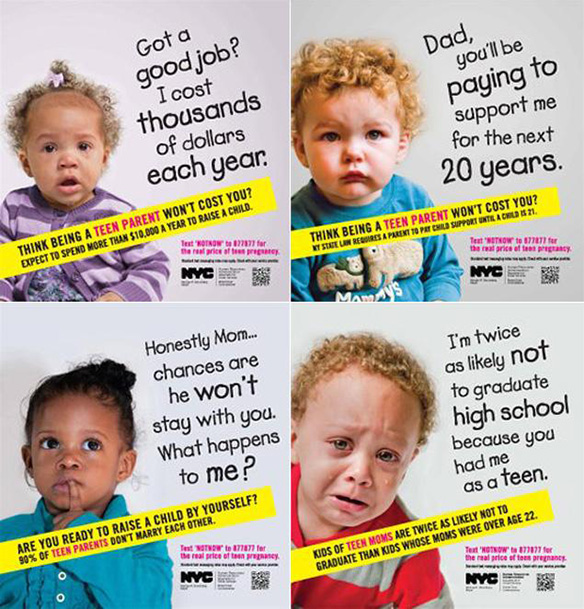Teen pregnancy, like obesity, is often framed as an “epidemic.” As such, both the “epidemic” of teen pregnancy and the “epidemic” of obesity can be understood through the lens of what sociologist Stanley Cohen popularized as a “moral panic.” In Cohen’s words, moral panics are “condensed political struggles to control the means of cultural reproduction”; additionally “successful moral panics owe their appeal to their ability to find points of resonance with wider anxieties.”
“The Real Cost of Teen Pregnancy”—a public health information campaign launched by Mayor Michael Bloomberg’s office and Human Resources Administration of New York City in March 2013—features babies and toddlers, primarily children of color, chastising their teenage mothers. Launched at a time when teen pregnancies have actually declined, primarily due to the availability of safe and affordable reproductive health care, the accusatory “shame and blame” narrative of these images is not only out of proportion to the “problem” it seeks to address, but is weighed down by its obvious cultural narratives about teens of color, poverty, gender, and sexuality.

Having a pensive toddler of color next to the slogan “Honestly Mom … chances are he won’t stay with you. What happens to me?” and a weeping boy of color next to the words “I’m twice as likely not to graduate high school because you had me as a teen,” serves to re-stigmatize single teen mothers, encouraging wider social senses of moral outrage, hostility, and volatility toward young, predominantly impoverished girls of color. Not unlike cultural narratives about “welfare queens,” the campaign plays into racist and classist fears about sexually active girls of color and teenage mothers who use social services. The message just under the surface here is about the need for social control of “unruly bodies.”
These 4,000 posters, put up in buses and subways, cost a reported $10,000 per year for the city, and have already drawn harsh critique from many. Haydee Morales, vice president for education and training at Planned Parenthood of New York City, for instance, has reportedly suggested the campaign has got it backward. In her words, “It’s not teen pregnancies that cause poverty, but poverty that causes teen pregnancy.”
According to Samantha Levine, a spokesperson for New York’s Mayor Bloomberg, “it’s well past the time when anyone can afford to be value neutral when it comes to teen pregnancy.” Public health campaigns are never value neutral. They communicate social beliefs about normalcy, productivity, desirability, and cultural worth.
An additional cost of the unexamined acceptance of this teen pregnancy campaign is accepting yet another narrative about individual choice over systemic change. Placing responsibility on the shoulders of the individual, such campaigns silence more complex conversations about accessible and affordable reproductive health care, anti-poverty campaigns, and gender and social justice work. Instead of buying into the “moral panic” of teen pregnancy, perhaps the mayor’s office might look into more long lasting and less stigmatizing possibilities of structural change to improve the lives of young women in New York City.
“Shame and blame” has rarely gotten public health anywhere. In the words of researcher and speaker Brené Brown: “Shame diminishes our capacity for empathy. Shame corrodes the very part of us that believes we are capable of change.”
This post originally appeared onSociological Images, a Pacific Standard partner site.





